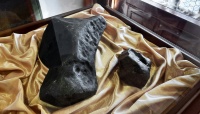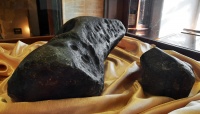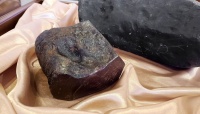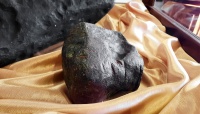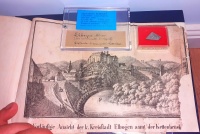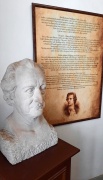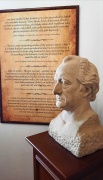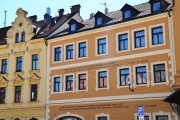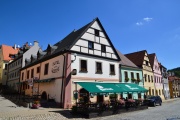(Unless otherwise stated, the copyright of the materials included belong to Jan Woreczko & Wadi.)
Elbogen/Galerie
Z Wiki.Meteoritica.pl
| Linia 20: | Linia 20: | ||
== Goethe w Loket == | == Goethe w Loket == | ||
| - | W okresie romantyzmu [[Loket]] wielokrotnie odwiedzał niemiecki poeta Johanna Wolfganga von Goethe (1749-1832), który miasto to umiłował i opisywał. Do dziś dawne wizyty tego wybitnego poety są przez mieszkańców wykorzystywane w promocji miasta. Można napotkać w nim wiele śladów po pobycie poety: jego pomnik, hotel ''Goethe'', a wiele kamienic zdobią cytaty. Więc nie tylko z zamku i meteorytu [[Elbogen]] słynie to miasto. | + | W okresie romantyzmu [[Loket]] wielokrotnie odwiedzał niemiecki poeta Johanna Wolfganga von Goethe (1749-1832), który miasto to umiłował i opisywał. Do dziś dawne wizyty tego wybitnego poety są przez mieszkańców wykorzystywane w promocji miasta. Można napotkać w nim wiele śladów po pobycie poety: jego pomnik, hotel ''Goethe'', a wiele kamienic zdobią cytaty. Więc nie tylko z zamku Loket i meteorytu [[Elbogen]] słynie to miasto. |
| + | |||
| + | Trochę prozy życia tego poety: | ||
<gallery caption="" widths="180px" heights="180px" perrow="4"> | <gallery caption="" widths="180px" heights="180px" perrow="4"> | ||
| - | File:Elbogen_(Goethe-1).jpg|Nie tylko uroki miejsca wzbudzały w poecie wiele emocji ☺: „''One of the most famous visitors to Loket. During his frequent stays in Karlovy Vary, Goethe visited Loket thirteen times altogether. The poet's best-known visit was his last visit on 28 August 1823 when he celebrated his 74th birthday at the Schwarzenberg view point. The celebration took place in the company of friends together with Mrs von Lewetzow and her three dauhters. Goethe got very emotionally interested in one of her daughters – the 19-year-old Urlika. This day was one of the happiest moments in life of the poet who was growing old. And by this day the castle of Loket left its footprint in the cultural history of the 19th century.''” | + | File:Elbogen_(Goethe-1).jpg|Nie tylko uroki miejsca wzbudzały w poecie wiele emocji ☺:<ref>o 30 lat młodsza żona Ignacego Domeyki Enriqueta de Sotomayor Guzman w dniu ich ślubu miała 15 lat</ref> „''One of the most famous visitors to Loket. During his frequent stays in Karlovy Vary, Goethe visited Loket thirteen times altogether. The poet's best-known visit was his last visit on 28 August 1823 when he celebrated his 74th birthday at the Schwarzenberg view point. The celebration took place in the company of friends together with Mrs von Lewetzow and her three dauhters. Goethe got very emotionally interested in one of her daughters – the 19-year-old Urlika.<ref>już dwa lata wcześniej 72-letni Goethe zalecał się do 17-letniej wówczas Theodore Ulrike Sophie von Levetzow; 2 lata później nawet jej się oświadczył, jednak Ulrike stanowczo zaprzeczała, jakoby miała romans z podstarzałym poetą</ref> This day was one of the happiest moments in life of the poet who was growing old. And by this day the castle of Loket left its footprint in the cultural history of the 19th century.''” |
File:Elbogen_(Goethe-3).jpg|W liście z 1819 roku do Carla Ludwiga von Knebel<ref>'''Karl Ludwig von Knebel''' – niemiecki pisarz, poeta i tłumacz; urodzony w zamku Wallerstein koło Nördlingen (przy kraterze {{Link-MBD|code=35286|name=Ries}})</ref>, bolał poeta nad rozbiciem okazu meteorytu na części: „''{{Kropek}}habe ich wieder{{Kropek}} Elbogen zweymal{{Kropek}} gesehen, wo der Überrest des Meteorsteins höchst merkwürdig ist. Jammerschade, daß man so ein kostbares Naturproduct in Stücken schnitt, eben als wenn man einen großen Diamanten spalten wollte, um sich darin zu theilen, oder wenn, nach Salomonischem Urtheil, ein halbirets Kind auch eine Art von Säugling wäre{{Kropek}}''” | File:Elbogen_(Goethe-3).jpg|W liście z 1819 roku do Carla Ludwiga von Knebel<ref>'''Karl Ludwig von Knebel''' – niemiecki pisarz, poeta i tłumacz; urodzony w zamku Wallerstein koło Nördlingen (przy kraterze {{Link-MBD|code=35286|name=Ries}})</ref>, bolał poeta nad rozbiciem okazu meteorytu na części: „''{{Kropek}}habe ich wieder{{Kropek}} Elbogen zweymal{{Kropek}} gesehen, wo der Überrest des Meteorsteins höchst merkwürdig ist. Jammerschade, daß man so ein kostbares Naturproduct in Stücken schnitt, eben als wenn man einen großen Diamanten spalten wollte, um sich darin zu theilen, oder wenn, nach Salomonischem Urtheil, ein halbirets Kind auch eine Art von Säugling wäre{{Kropek}}''” | ||
File:Elbogen_(Goethe-5).jpg|1 lipca 1807 roku Goethe napisał: „''Heute waren wir in Ellenbogen, das über alle beschreibung schön liegt und sich als ein landschaftlichen kunstwerk von allen seiten betrachten läbt.''” | File:Elbogen_(Goethe-5).jpg|1 lipca 1807 roku Goethe napisał: „''Heute waren wir in Ellenbogen, das über alle beschreibung schön liegt und sich als ein landschaftlichen kunstwerk von allen seiten betrachten läbt.''” | ||
Wersja z 20:47, 17 sie 2022
| Strona w budowie (Site under construction) Jeszcze to chwilę potrwa (It will take a while) |
Fragment meteorytu Elbogen i kopia masy głównej w zbiorach zamku Loket (Hrad Loket) (fot. Wadi & Jan Woreczko)
Płytka meteorytu Elbogen z kolekcji Alana Mazura (fot. Alan Mazur)
Litografia panoramy zamku Loket z broszury Anonymus (1834) |
Goethe w Loket
W okresie romantyzmu Loket wielokrotnie odwiedzał niemiecki poeta Johanna Wolfganga von Goethe (1749-1832), który miasto to umiłował i opisywał. Do dziś dawne wizyty tego wybitnego poety są przez mieszkańców wykorzystywane w promocji miasta. Można napotkać w nim wiele śladów po pobycie poety: jego pomnik, hotel Goethe, a wiele kamienic zdobią cytaty. Więc nie tylko z zamku Loket i meteorytu Elbogen słynie to miasto.
Trochę prozy życia tego poety:
Nie tylko uroki miejsca wzbudzały w poecie wiele emocji ☺:[1] „One of the most famous visitors to Loket. During his frequent stays in Karlovy Vary, Goethe visited Loket thirteen times altogether. The poet's best-known visit was his last visit on 28 August 1823 when he celebrated his 74th birthday at the Schwarzenberg view point. The celebration took place in the company of friends together with Mrs von Lewetzow and her three dauhters. Goethe got very emotionally interested in one of her daughters – the 19-year-old Urlika.[2] This day was one of the happiest moments in life of the poet who was growing old. And by this day the castle of Loket left its footprint in the cultural history of the 19th century.” |
W liście z 1819 roku do Carla Ludwiga von Knebel[3], bolał poeta nad rozbiciem okazu meteorytu na części: „…habe ich wieder… Elbogen zweymal… gesehen, wo der Überrest des Meteorsteins höchst merkwürdig ist. Jammerschade, daß man so ein kostbares Naturproduct in Stücken schnitt, eben als wenn man einen großen Diamanten spalten wollte, um sich darin zu theilen, oder wenn, nach Salomonischem Urtheil, ein halbirets Kind auch eine Art von Säugling wäre…” |
